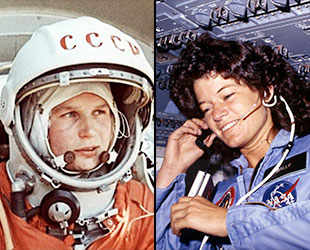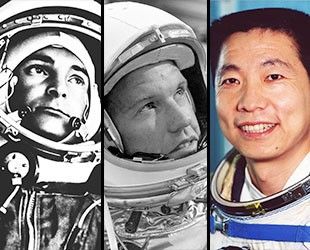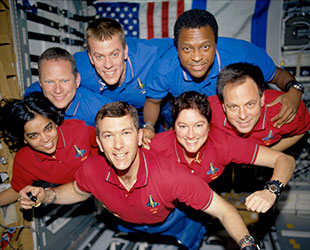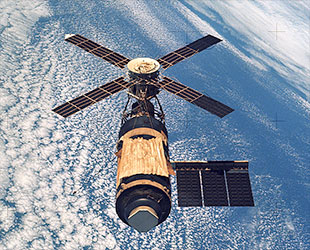Jan. 1, 2013 — "Spaceship" Earth has completed another revolution around the sun, and has set off on another 365 day, 583 million mile (940 million kilometer) journey across time and space.
Over the past year, humankind's efforts to push further out into the solar system have resulted in launching the first
commercial spacecraft to resupply the International Space Station, landing a
car-size rover on Mars,
docking the first Chinese manned spacecraft and sending 18 people to
live and work off the planet.
In 2012, two
probes completed the most detailed map of the moon's gravity and North Korea (controversially) joined the nations that have lofted a satellite into space.
Over the next 12 months, more commercial spacecraft will visit the station, new probes will be launched to the moon and Mars, and if all goes as planned, the first spacecraft created to fly paying tourists on suborbital spaceflights will leave the Earth's atmosphere for the first time.
As these and other firsts enter history, they will join a half century of international space milestones. Looking ahead into the year, 2013 will mark several key anniversaries for the events of the previous
five decades of human activity outside the Earth.
First women
Celebrations over the previous few years have marked the 50th anniversary of the first man in space, the first
United States' man in space, and the first
American man in orbit. The 40th anniversaries of the manned lunar landings was also commemorated.

2013 marks the 50th and 30th anniversaries of the first women in space: Valentina Tereshkova (left) and Sally Ride. (RSA/NASA) |
The new year brings with it the 50 year anniversary of the first woman in space. Launched by the Soviet Union on June 16, 1963, cosmonaut Valentina Tereshkova became the first female space explorer as she circled the Earth 48 times.
Flying under the callsign "Chayka" (Seagull), Tereshkova, aboard the Vostok 6 spacecraft, flew in orbit at the same time as Vostok 5 with pilot Valery Bykovsky on board.
Twenty years later on June 24, 1983, NASA's Sally Ride became the first
American woman in space. A member of the seventh space shuttle mission's crew, Ride circled the Earth aboard the orbiter Challenger for six days.
On July 23, 2012, Ride
succumbed to pancreatic cancer at age 61, less than a year before the 30th anniversary of her historic first spaceflight.
Last single men
Bykovsky, who shared time in Earth orbit with Tereshkova in 1963, set the record on that mission for the most time spent flying in space alone 50 years ago this June. His Vostok 5 mission landed after almost five days.

Solo in space: Valery Bykovsky, Gordon Cooper and Yang Liwei each flew history-making missions alone. (RSA/NASA/CSA) |
The last NASA astronaut to circle the planet solo,
Gordon Cooper, did so from May 15-16, 1963, for one day and 10 hours. His 22-orbit mission aboard "Faith 7" was the final flight of the United States' Mercury one-seater spacecraft program.
In the 50 years since Cooper flew, the only Americans to soar through space alone were the six Apollo pilots who orbited the moon solo and the two private pilots who won the suborbital X Prize in 2004.
China's first astronaut, or taikonaut, also flew alone, ten years ago this Oct. 15. Yang Liwei lifted off on Shenzhou 5 in 2003 for a one day, 14 orbit mission that established China as only the
third nation to send a human into space.
Fallen crew
The first major milestone anniversary of the new year is also perhaps its most solemn: 10 years since the
loss of space shuttle Columbia and the STS-107 crew.
Commander Rick Husband, pilot William McCool, mission specialists David Brown, Kalpana Chawla, Laurel Clark and Michael Anderson, and Israeli payload specialist Ilan Ramon were returning to Earth on board Columbia when the vehicle broke apart during reentry into the atmosphere on Feb. 1, 2003. The 16-day science mission was just 16 minutes from landing.
It was the second time a shuttle was lost in flight after the STS-51L crew was killed aboard space shuttle Challenger on Jan. 28, 1986.

The STS-107 crew strikes a "flying" pose for an in-flight portrait. The astronauts were tragically lost 10 years ago. (NASA) |
An investigation found that Columbia sustained damage to its left wing after foam from its external fuel tank fell and impacted the orbiter's leading edge during launch. Though NASA worked to prevent foam from separating from future tanks and additional safety measures were implemented, the decision was made to retire the shuttle fleet after the completion of the International Space Station.
In 2012, the remaining three retired shuttle orbiters were
delivered to museums for their permanent public display.
First outpost
Skylab, the United States' first space station, lifted off 40 years ago this May 14.

The United States' Skylab orbital workshop in Earth orbit. (NASA) |
Built into a modified upper stage of a Saturn V rocket, the orbital workshop was damaged at launch when its debris shield separated and tore away, depriving Skylab of most of its power, removing protection from solar heating, and threatening to make the station unusable. The first crew, which launched just days later, was able to save Skylab in the first ever in-space repair, by deploying a replacement heat shade and freeing the single remaining, jammed main solar array.
Skylab hosted 300 scientific and technical experiments, including medical studies on the adaptability of humans to zero gravity, solar observations and investigations into Earth resources. The program was deemed successful in all respects, despite its early mechanical difficulties.
Mission milestones
2013 also marks the:
- 30th anniversary of the first launch of space shuttle Challenger (STS-6) on April 4;
- 50th anniversary of the first winged craft in space, the U.S. Air Force's X-15 rocketplane with pilot Joe Walker, on July 19;
- 30th anniversary of Guion "Guy" Bluford becoming the first African-American in space on Aug. 30;
- 30th anniversary of the first (and only to date) use of a launch escape system on the launch pad, the former Soviet Union's Soyuz T-10-1, on Sept. 26;
- 40th anniversary of Soyuz 12, the return to flight for the Russian spacecraft (after the loss of the Soyuz 11 crew) on Sept. 27;
- 25th anniversary of STS-26, the first return to flight for the U.S. space shuttle program (after the loss of the STS-51L crew) on Sept. 28;
- 30th anniversary of the first European to fly on the space shuttle (Ulf Merbold) and the first launch of the European-built Spacelab on Nov. 28;
- 20th anniversary of the first mission to service the Hubble Space Telescope, STS-61, on Dec. 2.
- 25th anniversary of the first spacewalk (EVA) by a European astronaut (Jean-Loup Chrétien) on Dec. 9.
